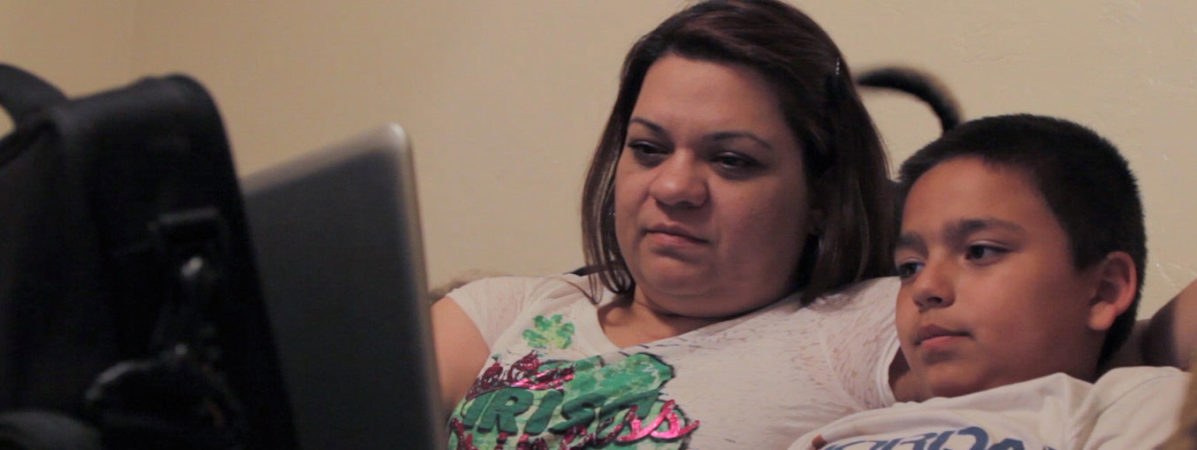
April 7, 2014 | By Digital Promise
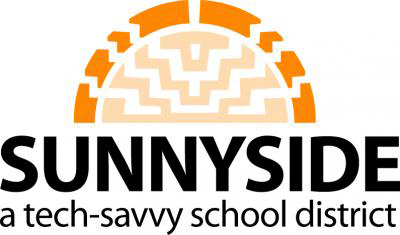
Location: Tucson, AZ
Enrollment: 17,265 students
Superintendent: Eugenia Favela
Per-pupil funding: $7,004
Low Income: 84.1%
Driving south along South 6th Avenue toward Challenger Middle School in Sunnyside Unified School District, the blacktop below and the Saguaro cactuses lining the street are both full of holes. There’s a sense of abandonment and decay. On the surface, it is a district that appears just as Superintendent Dr. Manuel Isquierdo describes it: One of families and students that feel “disenfranchised” and often with “no hope.”
Adjacent to Tucson Unified School District, Sunnyside is the smaller and more economically disadvantaged of the two, in a state that already ranks near the bottom of the country in per-student funding. More than 84 percent of the district’s 17,265 students are eligible for free or reduced lunch and 16 percent are English Language Learners (ELLs) from a home where the primary language spoken is Spanish. Six percent are homeless. And Johns Hopkins University, in a 2007 study, called the district one of the nation’s “dropout factories.”
Isquierdo joined the district that same year looking for ways to turn things around. Inspired by his own background, he looked to graduation and college success as the key goals for the district’s students. Both his grandparents and parents never finished high school, having immigrated from Jalisco, Mexico, to Saginaw, Mich., to work in farming and, eventually, the auto industry. One of five siblings, Isquierdo was the only one to go to college. “The families I serve today are like my grandparents,” he says of Sunnyside, which is 80 percent Hispanic.
As Pam Betten, who is now director of the district’s 1:1 laptop program, recalls, the district’s leadership thought: “If our ultimate goal is to have kids be successful when they leave school, and the world outside is changing, then we have to do something systematic to prepare them for that change.” In a community for which college and career success seemed far-fetched, he and his staff looked to technology as a way to raise expectations for students and connect them with the world outside Tucson.
In the fall of his first year as superintendent, Isquierdo launched “Project Graduation: Digital Advantage,” leveraging nearly $1.2 million in contributions from local companies to purchase netbooks for students at the district’s two high schools. To participate, students were required to have 95 percent attendance, maintain at least a 2.0 GPA, be involved in at least one activity, and have no suspensions for the first semester of their freshman year.
The approach worked, helping raise the number of graduates from 598 to 821 by 2010.
What began then as a small pilot to see if technology could help reverse the troubling academic trends at Sunnyside is now an evolving district-wide initiative called “One-to-One” that provides students in grades 4-12 with their own netbooks and laptops to take home. For families, technology has helped create a valuable bridge between home and school that previously did not exist. For administrators and teachers, there is evidence of the breakthroughs that come with a connected learning environment, and the challenges to be expected from such an ambitious and transformative approach to education.
By the time the initial pilot began to yield results, there was an urgency to sustain its momentum. Federal stimulus funds were available, and the district used those funds to launch its 1:1 program, with the goal of distributing laptops to every student in the district.
“We thought, ‘This is something good for the kids,’” Betten says. “The whole world was moving in that direction, and now we had the perfect opportunity to provide a wider group of students this experience.”
At the same time, Isquierdo and his staff sought a guide in launching the 1:1 project, with its bold goal of expanding digital technology to the rest of the district. A small leadership team began to research what was being done elsewhere and how digital technology could help the district. Among the resources used was Project RED, a national research project into 1:1 computing that offered a set of goals and best practices. The team began to see how it could meet some of the district’s most important needs: increased engagement in schoolwork, improved academic performance, and, at the high school level, decreased dropout rates and increased graduation rates.
First, the team piloted laptops to 5th graders in seven of 13 schools. By the spring of 2011, the district expanded the technology to all 5th grade classrooms. The team overseeing the project also began growing. By bringing principals into the fold next, the district could leverage school-level leadership to communicate to and gain buy-in from teachers. “We began to think more about putting systems in place to manage the project,” Betten says.
Within a year, those systems set the initiative on a fast track. The following year the district expanded into the 6th grade and in its third year the district gave students in grades 4, 6, 7, and 8 laptops all at once.
“It had huge potential for all kids,” Betten says. “It was too slow to move year by year.”
Beyond the initiative’s curricular and instructional impact, the district’s leadership immediately saw the potential to bridge the digital divide in the surrounding community.
Many students would be the first in their families to have a laptop, and inevitably would teach parents and other relatives about digital technology — much like children in the same community introduce English to their families. The district also hoped digital technology would improve communication between schools and parents.
The district scheduled a “Parent Night” at every school, in English and Spanish. “We would tell them what we were planning to do, why, what we hoped to gain, and address issues of online safety,” Betten says. Those events are now offered in the form of District Parent Council meetings where school leadership meet with parents, including volunteers who serve as paid liaisons between the district and the community.
That engagement is possible because Sunnyside decided not only to provide students with laptops, but also to connect its students beyond the school day. Students can take their devices home and families have options for low-cost Internet through business partnerships developed by the district. One, a national nonprofit program called Connect2Compete, brings together nonprofit organizations, Internet service providers, and local government to provide affordable Internet service to low-income families. In Tucson, Cox Communications offers Internet for only $9.95 a month.
Ivonne Gomez’s family shows the impact of home access in Sunnyside. A secretary at Los Amigos Technology Academy and a single mother of four, Gomez can’t afford computers for all her children, or market-rate Internet service.
On a visit to Gomez’s simple, ranch-style house, three of her four sons bunch next to her on the couch, while Roman, the oldest, sits on a chair grabbed from the next room. Ranging from fourth grade to high school senior, the boys have been bringing laptops home for three years. Roman benefitted from the 1:1 initiative as a freshman, which he says “made some classes more fun.” Abraham, who’s 14 and in eighth grade, says having a laptop to take home makes finishing assignments easier, because he can work at his own pace. Jonathan, a year younger, adds that in school, you can work with someone across the classroom, and share it in Google docs. He’s proud of a PowerPoint presentation he recently made.
Ivonne points out that having four tech-savvy children at home has helped her as well. In the effort to advance her own education at Pima Community College, she took a writing class, which required a PowerPoint presentation. Her sons taught her how to make one.
Isaac, the youngest at 9, chimes in that he recently got all the information he needed to make a poster on brain synapses from his laptop. “You find everything there,” Ivonne says.
Roman says he likes math and hopes to study engineering. Knowing how to use a computer “is going to help me a lot when I go to college,” he says. Ivonne, who’s 36 and came to the U.S. from Hermosillo, Mexico, when she was 10, also hopes to finish college, if she can afford it. “Then my son and I could get our diplomas together,” she says.
Ivonne Gomez’s house is one of nearly 400 that have signed up for low-cost Internet service since the Cox Communications program began. The district is even in the process of providing wireless internet on all of its buses. A May 2013 survey showed that 76 percent of the district’s households were now connected, a big jump from roughly 20 percent in a similar survey taken three years earlier.
For a district like Sunnyside, it would be easy to look at the 1:1 program’s impact on the community and be satisfied that the initiative is “working.” But the district knows digitally engaging the community can only go so far without a more robust strategic plan that includes clear instructional goals. Sunnyside wants its teachers to become facilitators, working next to students as they learn to learn from each other.
As Sunnyside – and many districts across the country — have realized, supporting such a systemic shift in instruction is difficult. And it is similarly challenging to measure the impact of this shift, including how it helps the district meet academic goals for its students.
One morning in January, Isquierdo and a group of visitors walked through several Sunnyside schools, observing and commenting on how chairs and desks were arranged in the classrooms. Were they lined up in neat rows, students listening to the teacher? Were laptops open on desks, much in the same way textbooks would be in traditional classrooms? Or were students bunched together in groups of two, four, or six, working at their own pace and consulting with each other?
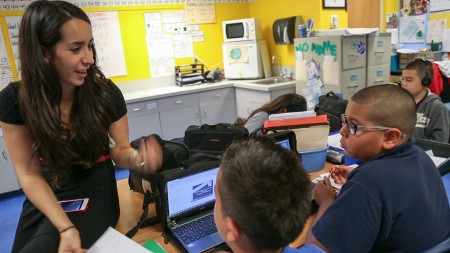
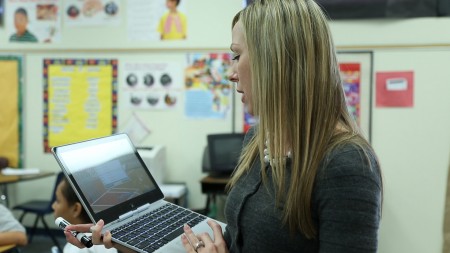
Isquierdo was looking for evidence that his district’s teachers were putting into practice one of its core beliefs: Student-driven use of digital technology together with small-group collaboration increases student performance. In addition to teachers becoming facilitators as students work at their own pace, students should be working together in project-based learning environments, solving real-life problems and discovering open-ended answers.
At Craycroft Elementary School, a 3rd grade class was midway through 20 minutes of individualized math work, after the teacher had given a short lesson. The students sat in small groups, talking to each other about the lessons on the screen. The teacher walked around the room, answering questions or pointing out mistakes. She was helped by her own laptop, which sat open at the front of the room running a program that told her, in real time, what problem each student was working on and whether he or she had the right or wrong answer. The screen showed the classroom’s seating arrangement, with different-colored squares at each seat. Red squares popped up at different spots on the screen, quickly identifying students who were getting wrong answers or falling behind.
In one 8th grade history class at Sierra Middle School, students in small groups were using historical information they found on search engines to make a Facebook profile of Abraham Lincoln. One boy passed his laptop to another and showed off what he had written. Still another worked in collaboration with a classmate and said, “Put my name there too!”
In other classes, however, students still sat in rows facing the front of the classroom, an approach the district believes doesn’t take full advantage of technology’s potential.
On these visits, Sunnyside’s staff notes which teachers “get it,” and which are still adapting – to giving up control of the classroom, to letting the students take charge of their learning, and to digital technology itself, with all its differences from printed instructional materials.
Betten says that she can tell where a teacher is at in the continuum after a few minutes in his or her classroom. Teachers who are still adapting, she says, “are still at the place where digital technology is almost mechanical. The technology feels foreign to the classroom, and not embedded.”
When speaking with teachers at Los Amigos Elementary School, they express satisfaction of moving beyond the first year and navigating the possibilities of instructional technology. But they also acknowledge a common frustration over the realities of the job, specifically the lack of time to learn the new approach, in addition to developing new lessons and adapting to new accountability measures from the state.
Teachers who “get it,” Betten says, “have a real flow, and are using [laptops] not for technology’s sake, but instead it’s more integrated.”
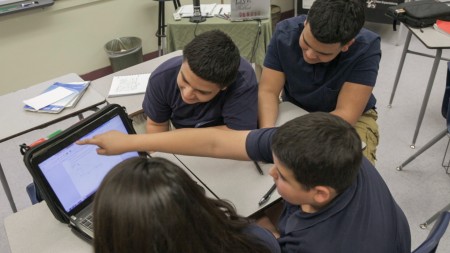
Interestingly, she notes that the two groups don’t always fall out as one would expect, with older teachers struggling to use laptops more than younger ones. Some teachers have difficulty in making the change because they’ve had some level of success with “traditional” classroom teaching, she notes. And there’s no data or study to show why some teachers are faster than others in integrating the technology.
“It’s hard to quantify, but the fact is, some teachers are more comfortable with change.”
To make this change as comfortable as possible, the district is shifting professional development from its initial focus on how to operate digital technology to treating the technology as a means to enhancing instruction. So, while teachers still receive training in the how-tos, starting in the project’s third year they have increasingly been exposed to technology’s ability to redefine the actual practice of teaching. For example, more experienced teachers offer summer courses to their peers in specific tools such as Google’s suite of apps, and their potential for the classroom. The district’s own website reflects this continuum, with a series of links that include classroom web resources, Moodle tutorials (the district’s learning management system), and other digital curriculum resources.
The district reorganized its instructional personnel to provide support and earn buy-in from the classroom level to the central office, with principals serving as the bridge. Sunnyside added a layer of administration, including a Director of Professional Development and a Director for One-to-One Project Management.
The district also integrated coaching and mentoring through new positions at the school and district level. Select teachers in grades 5-9 were moved out of classrooms and made District Technology Coaches for each of those grades, covering elementary, middle, and high school levels. District-level coaches provided nuts and bolts support in rolling out the 1:1 initiative, designing professional development courses on instructional technology use that are still offered to teachers today. In January 2011, the same model was used to create on-site Teacher Technology Facilitators at each school.
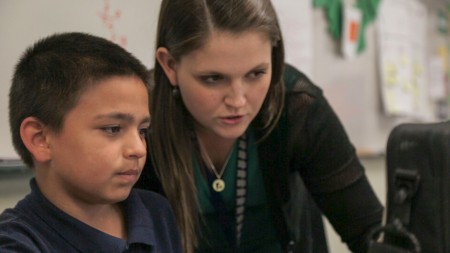
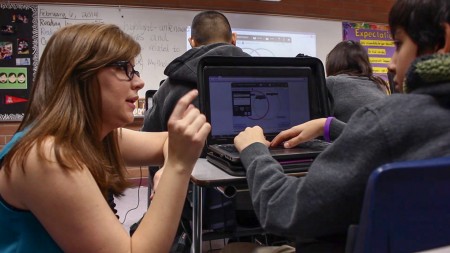
Pairing the district’s top-down planning with bottom-up support has meant that teachers have also played an important role in shaping the initiative. Early on, for example, elementary school teachers kept reporting problems with connectivity back to their principals. So the district’s Information Technology team upgraded bandwidth. Similarly, schools drove the system of work orders to deal with laptops that needed repairs. Each school has become a certified hardware repair center.
But teachers don’t only receive professional development from their peers and district staff. The district’s strategic business partnerships also provide opportunities. Intel Corporation and the One-to-One Institute, a Michigan nonprofit organization, trained the district’s teachers in 2010. Researchers from Arizona State University’s Center for Games and Impact also offer curricular materials and training.
Choices about what digital curriculum to use also affect whether teachers can meet the district’s instructional goals. In assessing curricular materials, Sunnyside’s leadership seeks tools that meet academic goals for students rather than those that simply deliver subject matter. As a result, the district works with a diverse group of vendors and partners, ranging from large, traditional publishers to smaller, newer companies.
The latter group has offered tools that are more interactive, particularly when it comes to adapting to Common Core requirements, Betten says. Many larger, more traditional companies are still developing digital materials that feel like online versions of textbooks, she notes.
“We’re trying to look for content that has a sort of relationship feel to it,” she says – like the interactive games being developed at Arizona State University and piloted at Sunnyside. Javier Baca, the district’s IT director, says, “We could just PDF everything and call it a technology-rich curriculum. But that’s not what we’re trying to do.”
From the outset, Sunnyside has viewed high school graduation as a crucial metric to evaluating digital technology. In 2008, when the initiative began, the district’s graduation rate of 71 percent was eight points behind the state average. It is now 82 percent, according to the Arizona Department of Education. While the 1:1 initiative is not the only cause of this increase, Sunnyside believes digital technology has made an impact.
“It created an incentive … a clearer focus on students and their progress,” Betten says. The technology also made it easier for students to recover class credits lost due to failing grades.
Moving forward, the direct impact of digital technology on academic performance will be difficult to measure. As the district shifts its standards to the Common Core, students have performed below expectations on the state’s former high-stakes assessment. As evaluation methods and curricular materials are aligned with those standards, Sunnyside hopes its forward-thinking approach will be validated.
Betten also expects the new standards will make it easier to gather longitudinal data on students in the future, so the district can better track pathways toward graduation and beyond. Additionally, the district has contracted with a group called Arroyo Research to gather data on the 1:1 program’s impact at all grade levels, including such measures as statewide tests, grade-level mastery, Advanced Placement test scores, and college credits accumulated during high school. The group will also look at what happens to students after they graduate, taking stock of college enrollment, college graduation, and professional careers.
Setting changing academic standards and accountability metrics aside, a visit to Sunnyside suggests that the 1:1 initiative’s most important outcomes include pushing a historically marginalized community toward a new self image, one that includes being a part of something bigger, on the cutting edge.
As Isquierdo puts it, “the real story is how it’s changed lives.”
On the southern edge of Tucson, in the San Xavier District of the Tohono O’odham nation, a Native American reservation, the 1:1 initiative appears to provide that community’s families a connection to school and a resource – digital technology – to call their own. Sprawling across 71,000 acres of desert, the San Xavier district is home to about 2,000 members of the Tohono O’odham nation, including several hundred who attend Sunnyside schools.
If you miss the turn that leads to the district’s learning center, the next right takes you up a dusty, unpaved road, stray dogs crossing from side to side. Tohono O’odham children toss a baseball. Cement-block, federally subsidized houses are scattered beyond, in the desert.
On turning back, the learning center is visible beyond a chain-link fence, the largest building around – and an Internet hotspot. Sylvia Dawavendewa, education program coordinator, says computers are not common in the community, both for economic reasons and because Internet connections are still spotty on the reservation. So dozens of children come to the center after school, sometimes sitting in hallways or even out front, as the hotspot stretches to 200 feet around the center. They do their homework and play games online, usually until dark, when Dawavendewa sends them home.
At home, parents have learned how to help their children take care of the laptops. Dawavendewa recalls one case where a child broke his laptop and parents had to meet with Sunnyside personnel to sort out financial liability. The child wound up losing his right to take his laptop home for the rest of the school year, and Dawavendewa used the incident as a cautionary tale for Tohono O’odham parents in the San Xavier community newsletter. “It’s been a whole learning process for the community,” she says.
She also thinks the program has had a positive impact academically and notes with pride that all 18 eligible seniors on the reservation graduated last year.
Francine Johnson greets all who enter the center. She lives “right under that mountain right there,” she says, pointing out the front door. Johnson has three daughters, including Dae Sean, who’s in 5th grade and has a laptop through 1:1 the district. Dae Sean used to read below a 2nd grade level, but online reading games have helped her greatly. “She felt embarrassed before, would get mad and not say anything. Now’s she’s not embarrassed,” Johnson says.
Amid both successes and shortcomings, Isquierdo, members of his leadership team, and principals and teachers all cite lessons they’ve learned in three-plus years of deploying nearly 10,000 laptops and tablets through the 1:1 program.
Isquierdo launched the district-wide initiative in 2010 to take advantage of federal stimulus funds, but only began developing a framework for everything – from deploying the technology to using laptops for improving curriculum and instruction – after the fact. With more planning time, perhaps some of the post-rollout growing pains could have been avoided.
Introducing digital technology to the district has also presented classroom management challenges. Initially, each teacher was free to use his or her learning management system of choice. But in a district where up to half of all classrooms include new students at any one time, it soon became clear that requiring one fully-integrated system was a better choice. Now all teachers use Moodle.
Sunnyside’s leadership probably scrutinizes the program’s pedagogical implications most, though, including whether digital technology is helping meet the underlying goal of improving learning. For instance, they wrongly assumed there would be greater comfort using laptops in the classroom at the high school level, Isquierdo says. So to correct that, he’s placing two district-level coaches in each of Sunnyside’s three high schools.
While observing a 6th grade English language arts class at Sierra Middle School, Isquierdo notes with satisfaction how students are sitting in pairs, not rows, and engaged in “peer editing,” an example of collaboration. But he also says the shift to putting students at the center of the classroom universe, and not teachers, and getting students to collaborate with one another, is an ongoing challenge. Collaboration may be less prevalent in the 9th and 10th grades, for example, as those students are the most recent ones to receive laptops, he says.
There’s no denying the district’s progress in changing the expectations of families that might otherwise have “no hope,” as Isquierdo says. But Sunnyside’s major concern moving forward is creating the same kind of momentum in the classroom, with all students learning in a collaborative and dynamic environment, rather than simply offering a digital version of an education that has not worked in the past.
“Now that we have implementation figured out, classroom instruction is the thing,” Betten says. “We will be concentrating on honing instructional practices that are reliably rigorous, as we work through new standards.”
The challenge for Sunnyside will be to continue to innovate even after having provided every student with a laptops over the past three years, a major and complex undertaking. Only then will be it possible to reach Betten’s goal: “To bring everyone up to speed and beyond.”
Story:
Tim PrattEditing:
Jason TomassiniVideo:
Gavin DunhamPhotography:
Gavin DunhamGraphics:
Jenny ShinContributions:
Kelsey Sheehy
By Rastee Chaudhry and Barbara Pape
By Tamara Tate and Pati Ruiz